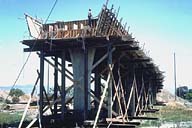
|
Image-GoddenG51
Highway overcrossing bridge. The east spans under construction. These consist of cast-in-place reinforced concrete box girders, continuous over all four spans, and with a short cantilevered end towards the camera from the near support. The false work is directly supported from the ground, and hence on removing the falsework the dead loading (as well as subsequent live-loading) is taken on the fully continuous system. (Richmond, California)
|
|
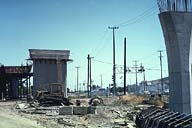
|
Image-GoddenG52
Highway overcrossing bridge. With the spans seen in GoddenG51 in the background, the single column in the foreground will support the similar cantilevered end of the two west box girder spans. The two spans between the cantilevered ends will be bridged by the precast prestressed hollow delta beams. (Richmond, California)
|
|
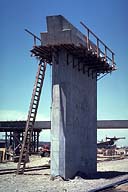
|
Image-GoddenG53
Highway overcrossing bridge. Close-up of the central support for the prestressed spans. Note the ledges that will support the ends of the precast beams, and compare with GoddenG56 where the beams have been placed. This support is the full width of the deck as the parallel delta beam construction used in the adjacent spans has little torsional rigidity. (Richmond, California)
|
|

|
Image-GoddenG54
Highway overcrossing bridge. Casting the prestressed concrete delta beams. This was done on the ground, and on the site. This slide shows the formwork and the reinforcing for the sloping webs of the beams. (Richmond, California)
|
|
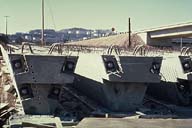
|
Image-GoddenG55
Highway overcrossing bridge. Completed delta beams showing the shear key reinforcement protruding from the upper surface, the lifting hooks at each end, and the prestressing tendon anchorages. The different prestressing design of the two beams shown is because, when in position, the center beam in the bridge (see GoddenG58) carries a higher load than the two outside beams. (Richmond, California)
|
|
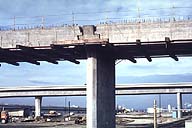
|
Image-GoddenG56
Highway overcrossing bridge. Close-up of the central pier after the delta beams have been placed. At this stage, and including the stage when the deck is cast, there is a temporary hinge on each side of the support. Subsequently for live loading the total section, consisting of the three delta beams and the deck slab, acts with full continuity (see GoddenG60) (Richmond, California)
|
|
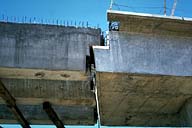
|
Image-GoddenG57
Highway overcrossing bridge. The other ends of the delta beams are supported on the cantilevered ends of the box girder sections. At this stage it is a hinge, and it is subsequently kept as an expansion joint for thermal expansion and shrinkage effects in the completed bridge as show in GoddenG58. (Richmond, California)
|
|
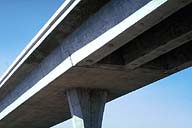
|
Image-GoddenG58
Highway overcrossing bridge. Close-up of the expansion joint of GoddenG57 after the casting of the deck slab and the completion of the bridge. (Richmond, California)
|
|
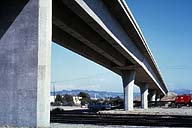
|
Image-GoddenG59
Highway overcrossing bridge. The completed bridge as viewed from the west, showing the junction between the delta beam spans and the box girder spans at the expansion joint of GoddenG58. (Richmond, California)
|
|
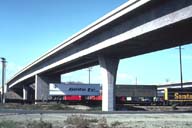
|
Image-GoddenG60
Highway overcrossing bridge. The completed bridge as viewed from the east, showing the precast spans crossing the railway lines and the central support of GoddenG56. (Richmond, California)
|
|












